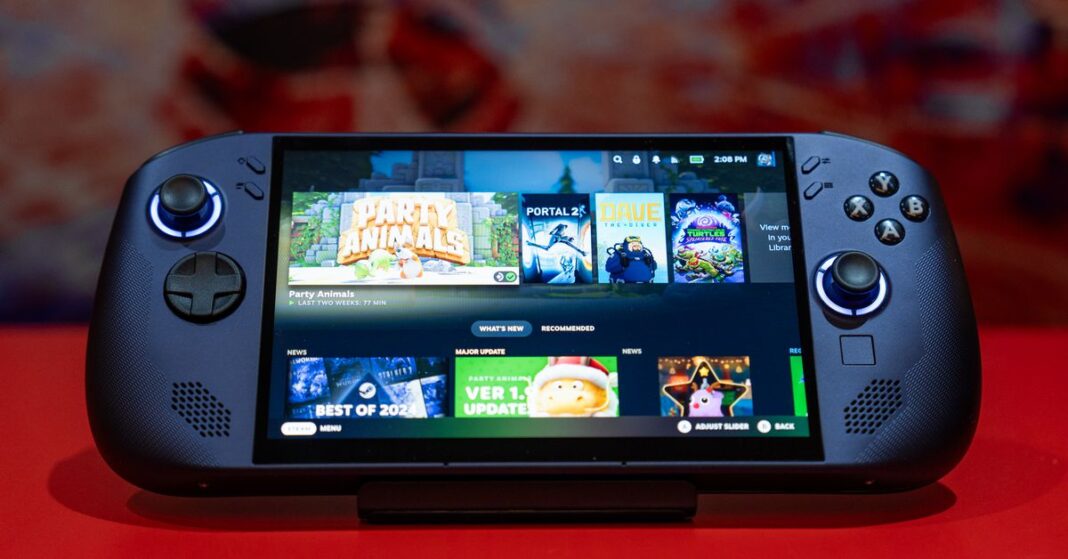Lenovo is attempting an experiment. In Might, it’s going to formally change into the very first firm exterior of Valve to ship a handheld gaming PC with the Steam Deck’s splendidly pick-up-and-play SteamOS as a substitute of Microsoft Home windows. And at $499, it’ll be a real Steam Deck rival, becoming a member of it as one of many lower-priced PC handhelds you should purchase.
That handheld would be the 1.6-pound Lenovo Legion Go S, a brand new and improved model of the corporate’s eight-inch handheld that ditches the Nintendo Swap-like removable gamepads and kickstand for a lighter and extra conventional design, with a sculpted grip that felt supremely comfy in my arms.
1/10
It’ll even be one of many few handhelds in the marketplace to supply a 120Hz variable refresh charge display — a extremely fascinating function that lets low-power handheld gameplay really feel clean, even when it’s not producing a number of frames. That display might be decrease in decision at 1920 x 1200, too, and have a hopefully power-sipping new AMD Ryzen Z2 Go chip. (It’s a Lenovo-exclusive chip, by the best way.)
In different phrases, it would deal with each main criticism I had in my Legion Go review, whereas moreover including enjoyable configurable RGB lighting across the joysticks, a barely bigger 55Wh battery, a pair of levers to scale back the throw of the triggers, and a much less obtrusive touchpad, too, whereas retaining the twin USB 4 ports.
However Lenovo isn’t going all in on SteamOS. Not solely will it hedge its bets by delivery a Home windows model of the Legion Go S as effectively nevertheless it’ll additionally ship with Home windows this month — 4 months forward of the SteamOS fashions. The Home windows mannequin is white:
1/6
It’s not just like the SteamOS mannequin is prepared now anyhow. Valve codesigners Lawrence Yang and Pierre-Loup Griffais inform me they’ve solely been working with Lenovo for a few months, and the combination isn’t fairly achieved. The brand new touchpad, gyroscope, and each RGB lighting and TDP configuration choices are among the many issues on their to-do checklist.
However the Home windows model delivery in January will value $729.99, with 32GB of RAM and 1TB of storage. In Might, the true experiment will start when avid gamers can decide between a $499.99 SteamOS model with 16GB / 512GB, a $599.99 Home windows model with 16GB / 1TB, or the Steam Deck and Steam Deck OLED at $399 and $549, respectively.
And it does sound like there might be one necessary cause to choose the Steam Deck over the Legion Go S and vice versa, as a result of AMD’s Z2 Go is a special chip. Whereas the Z2 Go announced yesterday sheds cores and GPU generations to be barely extra akin to the Steam Deck’s semi-custom Aerith and / or Sephiroth elements, we famous that it targets greater energy ranges, and Legion Go product supervisor Alex Zhu confirms to me that the Legion Go S is geared toward 20-watt efficiency, 30-watt, perhaps even 40-watt configurable efficiency, which is able to seemingly provide greater efficiency (and decrease battery life) than the 15-watt-and-below Steam Deck’s chip.
Zhu says Lenovo is focusing on between two and a pair of.5 hours of battery life in demanding heavy video games — which strains up with the fundamental math of dividing a 55 watt-hour battery by 20 watts, assuming the remainder of the system doesn’t eat up much more. Variations with AMD’s current Z1 Excessive chip will even be obtainable in some markets. All Legion Go S can match full-length M.2 2280 stable state drives.
BTW, Valve isn’t retaining key Steam Deck options like precompiled shaders to itself, or anything, for that matter. Yang and Griffais say will probably be one SteamOS, and the Legion Go S and any future SteamOS gadgets will get the identical updates because the Deck, minus hardware-specific tweaks.
Valve tells me Lenovo is at present its solely companion for a SteamOS machine — there aren’t any different third-party SteamOS gadgets at present within the works. However Griffais hints that Valve is near publicly releasing a brand new beta of its SteamOS that simply may probably begin engaged on different handhelds as effectively. (Valve beforehand confirmed to us that it was building toward some level of support for the Asus ROG Ally in SteamOS as effectively.)
And it’s vaguely attainable that SteamOS beta may arrive earlier than the SteamOS Legion Go S — Valve says it’s slated to ship someday after March.
However the actual dream is to tug a PC handheld out of a field and have it simply work, the best way a Nintendo Swap works, to not shoehorn an working system on it afterward, no matter how good the result. That’s why Lenovo is working with Valve: Zhu agrees that SteamOS has the perfect out-of-box expertise. However, he says, Home windows presents a complete ecosystem of gaming and productiveness that the corporate believes its clients nonetheless need.
Zhu agrees that SteamOS is an experiment for Lenovo and says it’ll take a look at the suggestions and momentum earlier than making its subsequent transfer. Talking of what’s subsequent, Lenovo can be constructing a bigger Legion Go 2 with removable controllers and an 8.8-inch OLED display, and it introduced prototypes of that unit to CES:
Photograph by Antonio G. Di Benedetto / The Verge
Zhu tells me Lenovo doesn’t have “any particular plans” to place SteamOS on the bigger Legion Go, simply Home windows — however maybe it is determined by what clients purchase in Might.
In the meantime, Valve continues to be looking forward to a future model of its personal Steam Deck, saying that partnering with corporations like Lenovo hasn’t diminished the need to construct its personal. However AMD’s Z2 isn’t the “leap” that Valve’s been waiting for, Griffais tells The Verge. There received’t be a Z2 Steam Deck.

